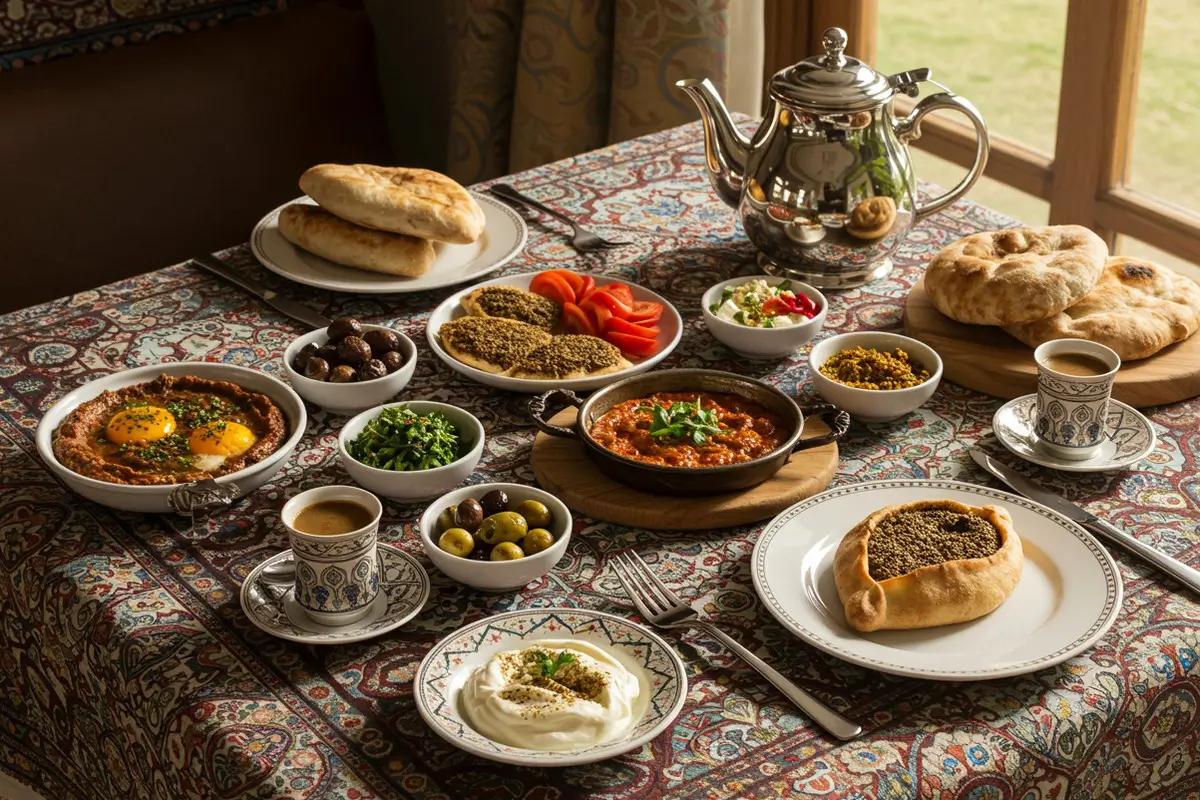Introduction to Breakfast in Arabic Culture
Breakfast holds a special place in Arabic culture, symbolizing more than just the first meal of the day. Rooted in traditions and marked by a rich variety of flavors, the Arabic breakfast reflects the region’s hospitality, history, and shared values. From hearty communal meals to simple breakfasts enjoyed with family, this meal is an expression of connection, culture, and identity.
In this article, we’ll explore the essence of breakfast in Arabic culture, diving into its ingredients, popular dishes, beverages, and social significance.
1. The Significance of Breakfast in Arabic Culture
1.1 Cultural Importance of Breakfast in Arab Society
Breakfast is often viewed as a way to start the day with both physical sustenance and emotional warmth. It is a common practice for Arab families to gather around the breakfast table, often sharing stories and discussing the day ahead. The communal aspect of breakfast reflects the Arab emphasis on familial bonds and collective living.
1.2 Historical Perspectives on Breakfast Traditions
Historically, breakfast in Arabic culture was influenced by the agricultural and trade practices of the region. Farmers would begin their day with simple yet energy-packed meals made from local ingredients, such as bread, cheese, and olives. As trade routes expanded, exotic spices and new culinary ideas enriched breakfast tables across the Arab world.
1.3 Religious and Social Influences on Breakfast Practices
Religious customs also play a role in shaping breakfast. During Ramadan, the pre-dawn Suhoor meal replaces the usual breakfast and includes foods that provide energy for fasting. Additionally, the act of sharing food and extending hospitality to guests during breakfast underscores the Islamic values of generosity and kindness.
2. Key Ingredients in an Arabic Breakfast
2.1 Traditional Staples: Bread, Olives, and Cheese
The backbone of any traditional Arabic breakfast includes simple yet flavorful staples such as flatbreads (khubz), marinated olives, and a variety of fresh cheeses like labneh and halloumi. These ingredients are often paired with hummus or za’atar for an added burst of flavor.
2.2 Common Spices and Herbs in Breakfast Dishes
Arabic breakfasts are renowned for their use of spices and herbs, such as cumin, sumac, and mint. These not only enhance the flavors of dishes like ful medames but also reflect the region’s deep culinary heritage.
2.3 Regional Variations in Ingredients
Each Arab country boasts its own unique breakfast ingredients. In Lebanon, thyme-infused manakish is a favorite, while in the Gulf, balaleet—a sweet and savory vermicelli dish—is widely loved. These variations highlight the diversity within Arabic cuisine.
3. Popular Arabic Breakfast Dishes
3.1 Ful Medames: A Hearty Fava Bean Dish
Ful medames is a classic breakfast dish made with cooked and mashed fava beans, seasoned with garlic, lemon juice, and olive oil. Often served with fresh bread, it’s a hearty option that sustains energy throughout the day.
3.2 Manakish: The Arabic Flatbread Pizza
Manakish is a versatile flatbread topped with za’atar, cheese, or minced meat. Popular in the Levant region, this dish is a go-to breakfast choice for its simplicity and rich flavor.
3.3 Shakshuka: The Egg-Based Delight
Shakshuka, a dish of poached eggs in a spiced tomato sauce, has become a beloved breakfast option not just in the Arab world but globally. It combines basic ingredients with bold spices to create a comforting meal.
3.4 Balaleet: Sweet and Savory Combination
Balaleet is a unique Gulf dish combining sweetened vermicelli with spiced scrambled eggs. This intriguing blend of flavors makes it a favorite in countries like the UAE and Qatar.
4. Breakfast Beverages in Arabic Culture

4.1 Traditional Teas
Tea is a staple beverage at any Arabic breakfast table. Black tea infused with cardamom or mint is particularly popular, providing a soothing accompaniment to the morning meal.
4.2 Arabic Coffee (Qahwa) and Its Rituals
Arabic coffee, known as qahwa, is an essential part of breakfast in many Arab households. Its preparation and presentation often involve elaborate rituals, emphasizing hospitality and tradition.
4.3 Refreshing Drinks and Juices for Breakfast
Fresh juices made from ingredients like oranges, pomegranates, and dates are also common at breakfast. These beverages provide a refreshing balance to the rich and flavorful dishes.
5. Modern Trends and Fusion in Arabic Breakfasts
5.1 Influence of Western Breakfast Traditions
In recent decades, globalization has introduced Western-style breakfasts to many Arab countries, particularly in urban areas. Pancakes, croissants, and omelets have become common additions to breakfast menus, often reimagined with a local twist. For example, a croissant might be stuffed with za’atar or labneh, merging Western techniques with Arabic flavors.
5.2 Healthy and Vegan Breakfast Options
Health-conscious eating has inspired many Arab households to include more nutritious options in their breakfasts. Families now pair traditional staples, like salads with cucumbers, tomatoes, and herbs, with modern choices such as avocado or hummus to create vegan-friendly meals. More people actively choose gluten-free breads and dairy alternatives, including almond or oat milk, to suit evolving dietary preferences.
5.3 Fusion Dishes: Blending Arabic and Global Flavors
Fusion dishes that blend Arabic and global cuisines have gained popularity. For instance, shakshuka pizzas and za’atar-flavored quinoa bowls cater to younger generations seeking a balance between tradition and innovation. This trend highlights how Arabic breakfasts continue to evolve while preserving their essence.
6. Social Aspects of Breakfast in Arab Households
6.1 The Role of Family in Breakfast Rituals

In many Arab households, breakfast is more than a meal—it’s an opportunity for family bonding. Sitting together around a shared platter of food fosters communication and connection. This tradition reinforces the importance of family ties in Arab culture.
6.2 Breakfast Gatherings and Hospitality
Breakfast is often a communal affair, with guests warmly invited to join the meal. Serving traditional dishes like manakish or ful medames to visitors reflects the Arab value of hospitality. These gatherings can extend for hours, especially on weekends or holidays, making breakfast a time to socialize and strengthen relationships.
7. Breakfast in Urban vs. Rural Areas
7.1 Traditional Breakfast Practices in Rural Areas
In rural Arab areas, breakfast retains a more traditional character. Meals often include freshly baked bread, homegrown olives, and dairy products such as laban or labneh. Rural breakfasts emphasize simplicity and are deeply connected to the agricultural lifestyle.
7.2 Evolving Urban Breakfast Habits
In urban centers, breakfast habits have adapted to busy lifestyles. Quick options like stuffed sandwiches or pre-packaged foods are common for those on the go. However, traditional elements like tea, Arabic coffee, and fresh dates remain integral, ensuring the essence of Arabic culture is not lost.
7.3 Street Food and Quick Breakfast Options
Street food has become an integral part of breakfast in cities. Vendors often sell manaqeesh, falafel sandwiches, or fresh juices, offering affordable and convenient options for workers and students. These quick meals highlight how breakfast traditions have adapted to modern urban life.
8. Reflection on Arabic Breakfast Culture
Arabic breakfasts are a rich tapestry of history, culture, and culinary artistry. From hearty dishes like ful medames to the intricate rituals surrounding Arabic coffee, breakfast in Arab culture goes beyond mere sustenance. It is a celebration of family, hospitality, and tradition.
Whether enjoyed in rural simplicity or infused with modern influences in urban areas, the essence of an Arabic breakfast remains deeply rooted in the values of sharing and connection. By embracing both tradition and innovation, this meal continues to hold its special place in the hearts of people across the Arab world.
9. FAQs
1. What is a traditional Arab breakfast?
A traditional Arab breakfast often includes staples like flatbreads, olives, fresh cheeses, and dishes such as ful medames or manakish. These meals are usually accompanied by tea or Arabic coffee.
2. What is the Arabic name for breakfast?
In Arabic, people call breakfast “فطور” (futoor). The term refers to the first meal of the day and comes from a root word that means “to break the fast.”
3. What do Saudis eat for breakfast?
In Saudi Arabia, breakfast commonly includes dishes like ful medames, shakshuka, and fresh bread served with cheese or honey. Arabic coffee and dates are also popular choices.
4. What is the meaning of Brekkie in Arabic?
“Brekkie” is a casual slang word for breakfast in English. Arabs translate it as “فطور” (futoor), although Arabic does not have a direct equivalent that matches the informal tone of “Brekkie.”
Conclusion
Breakfast in Arabic culture is far more than a meal; it is a reflection of the region’s deep-rooted traditions, values, and hospitality. From simple rural breakfasts featuring fresh, locally sourced ingredients to the modern fusion of global and Arabic flavors in urban areas, this meal encapsulates the diversity and unity of Arab society.
At its heart, breakfast serves as a means of bringing people together, whether through family bonding, social gatherings, or the exchange of cultural heritage. The rich array of dishes—like ful medames, shakshuka, and manakish—paired with aromatic beverages such as Arabic coffee and mint tea, offers a sensory journey into the culinary heart of the Arab world.
As lifestyles evolve and globalization shapes new habits, the Arabic breakfast continues to adapt while preserving its essence. It remains a testament to the region’s ability to honor its past while embracing the future.
More Delicious Recipes
- How to Eat Arabic Breakfast: A Complete Guide to Flavor, Culture, and Tradition
Can You Make Breakfast Sliders the Night Before? Ultimate Guide to Meal Prep

